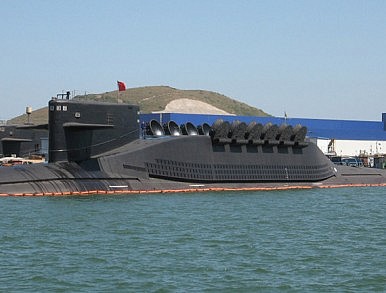By Ankit Panda
On November 24, the Chinese People’s Liberation Army-Navy conducted the first known flight-test of the JL-3 solid-fuel, submarine-launched ballistic missile (SLBM), U.S. government sources with knowledge of the test confirmed to The Diplomat.
The test, which was first reported by the Washington Free Beacon, took place in the Bohai Sea from a modified conventional submarine, the sources said. The Type 096 nuclear ballistic missile submarine (SSBN) remains under construction and is expected to begin sea trials in three to four years.
Chinese authorities have not publicly confirmed the test.
The test on November 24 did not see the JL-3 fly to its full range. The first flight test likely verified the system’s proper cold ejection from the submarine-based launch tube. The missile’s full range is likely to be in excess of 9,000 kilometers, according to U.S. intelligence estimates.
The JL-3, along with the Type 096, will mark the modernization of China’s sea-based nuclear deterrent, which became operational only recently. Currently, Beijing is known to operate at least four, but possibly as many as six, Type 094 SSBNs armed with the JL-2 SLBM—an SLBM based off the land-based DF-31 solid-fuel intercontinental-range ballistic missile.
The JL-3 is expected to offer a considerable range extension over the JL-2, which has been estimated by U.S. military intelligence to possess a range of just over 7,000 kilometers. That means the SSBNs carrying these missiles would be out of range of continental United States-based targets.
The range of the JL-3, meanwhile, would allow Chinese submarines to strike at continental U.S. targets from further away, increasing their survivability by reducing the need to navigate into contested waters in the Western Pacific in a conflict, for example.
“China’s four operational JIN-class SSBNs represent China’s first credible, seabased nuclear deterrent,” the U.S. Department of Defense’s 2018 report on Chinese military power noted.
“China’s next-generation Type 096 SSBN, reportedly to be armed with the follow-on JL-3 SLBM, will likely begin construction in the early-2020s,” it added.
Given the expected life-spans of both the operational Type 094 and the next-generation Type 096, the People’s Liberation Army-Navy is likely to operate both types of SSBNs concurrently. All of China’s operational Type 094 SSBNs are based at a base near Yulin on Hainan Island in the South China Sea.
The total size of China’s planned SSBN force remains uncertain, but it is likely that Beijing will shift its efforts away from the Type 094/JL-2 to the Type 096/JL-3 in the coming years.

No comments:
Post a Comment